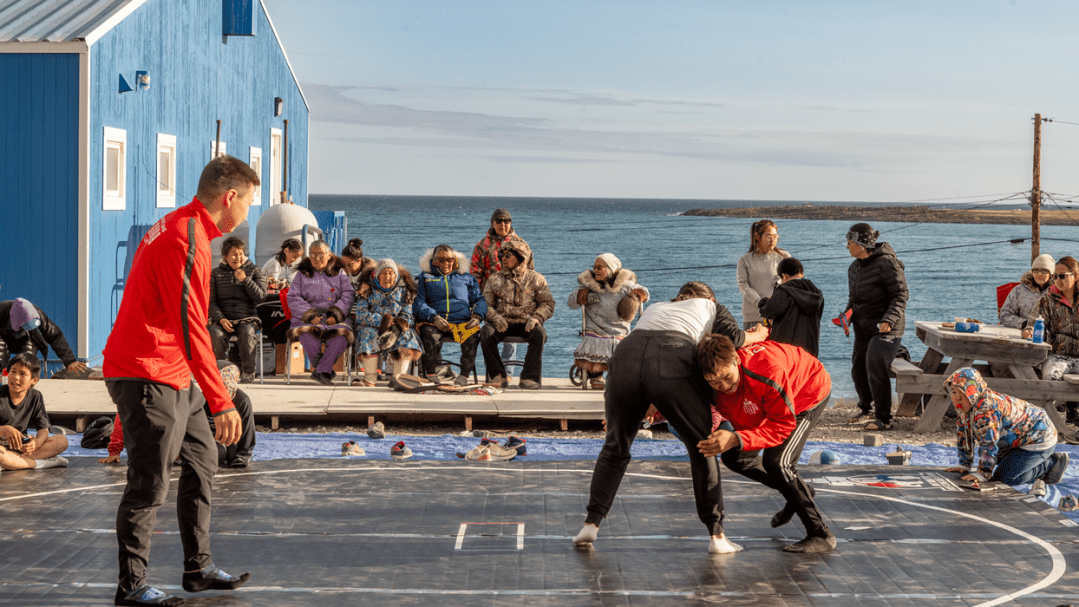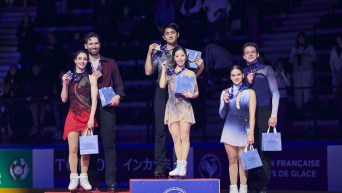Olympian Leah Ferguson’s visit to Ulukhaktok’s modern day wrestling “kalgik”
“Wrestling in the Arctic began with our Inuit ancestors wrestling in a large community igloo called a kalgik. The kalgik was a place for hunters to maintain their physical fitness and showcase their strength. It also established community. We plan to establish a modern day kalgik: a new wrestling room in the old community curling arena next to the school.”
Build community. Connect to culture. Encourage play. That was the mission for Jacob Klengenberg and Monique Smith when they applied for a 2025 Team Canada Olympic Day Grant that would provide funding for new equipment in their modern day kalgik. The new wrestling space will support the students of Helen Kalvak Elihakvik School in Ulukhaktok, N.W.T., where the school population is 99 per cent Inuvialuit. Ulukhaktok is located in the Arctic Circle on the west coast of Victoria Island.
Observations from both community elders and academic research have shown a decline in community connection, and increased risk for mental health struggles amongst Indigenous youth.
“Our wrestling program has become a metaphorical kalgik—a place where students experience community, showcase their strength, and connect to their ancestral roots through traditional games intertwined in our training,” said Klengenberg, who was honoured as the 2024 National Indigenous Coach of the Year.
“Our program focuses on building up mental health and resiliency. We are building into our older athletes, training them to become leaders and assistant coaches to younger student-athletes.”
Klengenberg and other Ulukhaktok coaches were trained through Olympian Leah Ferguson’s “Power of Play” program, which was designed to teach non-wrestlers how to coach wrestling and received an OLY Canada Legacy Grant this year. The curriculum focuses on core aspects of physical literacy, such as footwork, balance, core, and reaction. And as the name suggests, play, rather than competition, is the emphasis.
To help get momentum rolling with the new kalgik, Ferguson made a visit to the northern community to host workshops and practices for students of all ages, connect with coaches, and offer expert advice on the new space set up. As a fly-in community, the logistics and expense of bringing in new equipment are far from simple.
While it was obviously exciting to have an OIympian visit, Ferguson said that first and foremost she wanted to impress upon students what a great job the adults in their own community are doing—Klengenberg, Smith, and phys-ed teacher, Santana Gaudet, among them.
Ferguson’s approach to teaching wrestling is, well, not really focused on teaching “wrestling” at all. Ferguson’s curriculum focuses on foundational movement, as well as consent/body awareness, emotional composure and positive body image—all life skills that extend far beyond the wrestling mat.
As a contact-driven combative sport, Ferguson says that consent is crucial in wrestling, though lessons of consent ripple far beyond the gym.
“Consent and body awareness is knowing when you’re in someone’s bubble, and someone’s in yours, and that it’s okay at any point to say it’s not okay anymore,” said Ferguson. “You can be in class and you can be having fun, and you can become uncomfortable and you’re allowed to sit out. And then you can think class looks fun again, and you’re allowed to rejoin.”
Ferguson also talks about the importance of shaking hands and making eye contact before wrestling.
“The golden rule is to keep yourself safe and keep everyone else around you safe, and you’re shaking hands on that rule, which is different from other combative sports where there can be intention to harm. In wrestling, there’s not that intention,” said Ferguson.
Relatedly, Ferguson talks about the importance of emotional composure in a sport with injury risk.
“We talk about why breathing and connecting to your body matter, and why having a positive understanding of failure matters,” said Ferguson.
Body image to Ferguson means talking about how there’s no one “right” wrestling body.
“Everyone’s body can be powerful. We talk about: what does it look like to be powerful if you’re tall and lanky? What does it look like if you’re short? We talk about different shapes and sizes of bodies and how power is generated in each of them,” said Ferguson.
She’s also aware that her physical presence can offer an opportunity for teenage girls, in particular, to engage.
“I think part of it is just that I’m a bigger woman. When I go to visit communities, girls come out when I’m teaching because there’s a bit of ‘oh this is interesting, the school brought in this aggressive, assertive lady, who’s tall and big like me.’
“This aggressive outlet is often given to boys. But when it’s given to girls it’s often under the guise of ‘self-defense,’ which doesn’t evoke playfulness,” said Ferguson.
Ferguson is a strong proponent of the long-term athlete development model, and play-based exploration of sport. Throughout her career, Ferguson has learned a lot about holistic development from Indigenous communities with whom she has had the opportunity to collaborate. She previously received an OLY Canada Legacy Grant in 2021 for a grassroots wrestling program focused solely on preparing youth for the 2023 North American Indigenous Games.
“Cultural forms of play help get us removed from this sport hierarchy,” said Ferguson. “Different communities train their kids with so many of these body games that are really the foundation of turning, pivoting, footwork, and balance.”
While the hope is that the modern kalgik space will be up and running in the coming weeks, Ferguson’s visit energized the wrestling community and beyond in the small northern town.
“Before I was flying out, Santana [Gaudet], the gym teacher, told me that the kids asked her to do wrestling again,” said Ferguson. “So they did wrestling again.”




